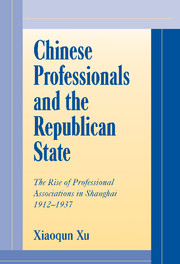 Chinese Professionals and the Republican State
Chinese Professionals and the Republican State Book contents
- Frontmatter
- Contents
- List of Tables
- Acknowledgments
- Abbreviations of Frequently Cited Sources
- Introduction
- Part I Professions and Professionals
- 1 Professions in Early-Twentieth-Century Shanghai
- 2 Professionals as Urban Middle Class
- Conclusion to Part I
- Part II Social Institutions, State Actions, and Professionalization
- Part III Professionalism, Nationalism, and Politics
- Conclusion
- Glossary
- Bibliography
- Index
2 - Professionals as Urban Middle Class
Published online by Cambridge University Press: 07 September 2009
- Frontmatter
- Contents
- List of Tables
- Acknowledgments
- Abbreviations of Frequently Cited Sources
- Introduction
- Part I Professions and Professionals
- 1 Professions in Early-Twentieth-Century Shanghai
- 2 Professionals as Urban Middle Class
- Conclusion to Part I
- Part II Social Institutions, State Actions, and Professionalization
- Part III Professionalism, Nationalism, and Politics
- Conclusion
- Glossary
- Bibliography
- Index
Summary
DURING the period under study a number of social surveys were conducted (some sponsored by the GMD government) on the economic conditions of Shanghai workers. But there has been no systematic collection of data providing information on the living and working conditions of any professional groups. Accordingly, the scholarship on Republican China has been unable to discuss in any detail how those groups variably called “professional groups,” “middle class,” and “new urban elite” actually led their daily life. This chapter represents a first effort to fill in this blank, though anecdotal information must be used, where systematic data are lacking, in order to get the fullest possible picture of the life experience of Chinese professionals in Republican Shanghai.
THE LIFE OF PROFESSIONALS
Professional Income
Before describing the income and living standards of Chinese professionals in Republican Shanghai, this study briefly addresses the question of what currency was involved. The history of Chinese currency is a complicated subject and obviously cannot be fully treated here. As far as prewar Shanghai is concerned, however, the picture was relatively clear. For the most part the silver dollar (yinyuan) and silver tael (yinliang) were the basic currency. Foreigners customarily referred to the silver dollar as the Mexican dollar (Mex), although in reality by the 1920s the Yuan (Shikai) dollar (Yuan datou) increasingly replaced the Mexican dollar in circulation, because of the former's lower silver content.
- Type
- Chapter
- Information
- Chinese Professionals and the Republican StateThe Rise of Professional Associations in Shanghai, 1912–1937, pp. 50 - 77Publisher: Cambridge University PressPrint publication year: 2000
